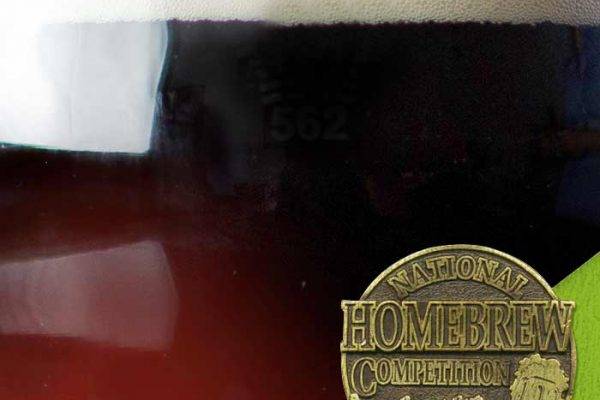

… Read the rest “5 Medal-Winning Eisbock Homebrew Recipes”
"Watching the game, havin’ a Bud."
The March/April 2024 Zymurgy magazine is now available! Check out topics on hop water, NA beer, low-carb beer, and Bavarian session lager. Plus 16 recipes!
The post March/April 2024 Zymurgy Magazine Now Available appeared first on American Homebrewers Association.
American Homebrewers Association… Read the rest “March/April 2024 Zymurgy Magazine Now Available”
This is a blend of two beers, refermented with grape juice concentrate from a 1-gallon winemaking kit.
The first beer is a Flanders red–style ale. Mash 60 min. at 152°F (67°C). The only hop addition is 2 oz. of low-alpha Strisselspalt at 60 min. Chill to pitching temperature of about 70°F (21°C), and pitch House and/or Roeselare blend of microbes. Primary 30 days in an HDPE container. (Some natural oxygen ingress through the HDPE during primary is desirable for the style.) Secondary at least 6 months, or as much as 18 months in stainless steel.… Read the rest “SFB 21 Wild Ale”
Bière de garde is a malty style of beer that is undiscovered to many. Translated to “beer for keeping,” the style was traditionally brewed in Northern France. Comparable to a Belgian saison, this beer is known for its malt-focused, toasty taste, and slight sweetness.
Visually, it is clear to slightly hazy, and the color is light amber to chestnut brown or red, largely dependent on which variation it is: blond, brown, or amber. This malt-forward brew’s hop aroma, flavor, and bitterness are low to medium, often with a soft to mouth-coating body.… Read the rest “Bière de Garde: ‘A Breath of Fresh Air’”
Move over light lagers, we’ve got something big to talk about.
Eisbock—pronounced “ice-bock”—is a German-style dark lager with a strength (9-14% alcohol by volume) rivaled only by the strong malt flavors. The eisbock-making process typically involves a freeze distilling/concentrating step as well as extended periods of lagering.
Ready to get started? Try out these 5 gold medal-winning eisbock recipes from the National Homebrew Competition.
For even more world-class beer recipes, including hundreds of NHC winners, visit the AHA’s Homebrew Recipe Library.


… Read the rest “5 Medal-Winning Eisbock Homebrew Recipes”
By Chris Williams, National Homebrew Competition Director
Get ready to show off your brewing skills, and let’s have some fun! Registration for the 2024 National Homebrew Competition (NHC), the world’s largest homebrew competition, opens later this month, on Tuesday, February 27, at 10:00 a.m. MT and will be open through Friday, March 15, or until capacity is reached.
For details about this year’s competition, please read my Director’s Update and visit the website. Key dates and locations are listed below.
Mash at 122°F (50°C) for 30 min, 152°F (67°C) for 75 min, 168°F (76°C) for 10 min. Sparge with 180°F (82°C) water. Boil for 90 min. Hops used in boil included homegrown Centennial hops aged at room temperature for 4 years, and other low-alpha hop pellets set out at room temperature for a few years.
Pitched Roeselare Ale Blend and added dregs from a few wild fermentation beers I enjoyed. Fermented at basement temperatures between 62°F (17°C) and 72°F (22°C) year-round.
Brewed this five times over the course of about 14 months with minor variations due to ingredients on hand in order to step up the culture by re-pitching fresh wort on yeast cake/culture and transferring clearing wort into secondary fermenter.… Read the rest “Bière Vide Lambic”
Since the rise of craft beer back in the 1980s and 90s, we’ve seen trend after trend come and go. And as more and more breweries opened and beers were introduced to the masses, brewers needed to find ways to set themselves apart from the glut. So, they tinkered.
With beer, you have some leeway to throw ingredients at the proverbial wall to see if they stick. Some do, and some don’t.
In the case of this trending style, the smoothie sour, it all started with the original, fruited sour and its similar brethren, such as the Gose.… Read the rest “Cheesecake and Ice Cream and Blueberry, Oh My: The Allure of Smoothie Sours”
The board of directors of the Brewers Association, the 501(c)(6) parent organization of the American Homebrewers Association (AHA), recently met and approved a restated set of association bylaws. The existing bylaws were drafted last century, had undergone many amendments over the decades, and needed modernization to comply with current best practices.
A summary of substantive changes related to the AHA includes the following:
Copyright © 2024 Whazup.com
